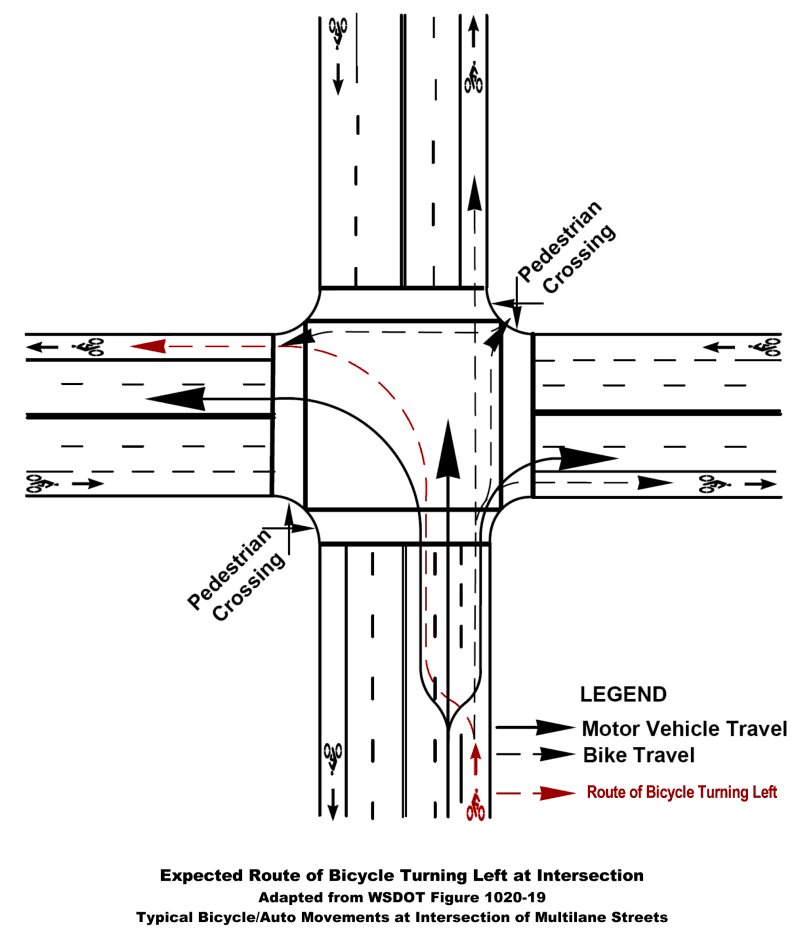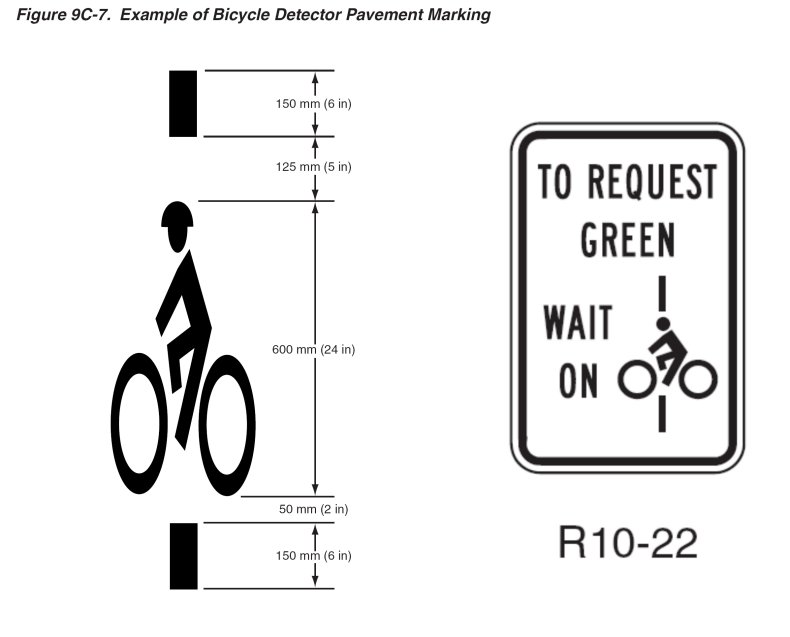Detection of Bicycles at Intersections:
A Question of
Safety
Many intersections have signals controlled by systems that detect vehicles waiting for a green light. The most common systems use loops of wire embedded in the pavement. These loops function like metal detectors, identifying the presence of vehicles because their bodies conduct electricity, disrupting the magnetic field around the coils.
Unfortunately for bicyclists and many motorcyclists, some jurisdictions do not consider smaller vehicles when installing and adjusting traffic light sensors. Some traffic engineers do not think of smaller vehicles, others mistakenly believe that inductive loops cannot detect bicycles or small motorcycles. Bicyclists and motorcyclists are left sitting at red lights through mutliple cycles of the lights, unable to trigger a green light for their signal. Sometimes this is an inconvenience -- if a cyclist is in the right lane, it is often possible to walk over to a pedestrian button to trigger a green light.
But consider the plight of a cyclist trying to make a left turn
on a multi-lane street: 
After determining that a sensor has failed to detect his vehicle, the cyclist does not have a pedestrian button available to trigger the light. One option is to treat the signal as defective, wait for an opening in traffic, and carefully proceed against the red light. The other is to walk to the pedestrian button, which requires crossing one or more lanes of traffic on foot, without the benefit of a protected pedestrian signal phase. Also, the pedestrian button does not trigger a left-turn signal, only a pedestrian crossing, so the bicyclist or motorcyclist must make two pedestrian crossings in place of a single left turn.
A Known Problem With Established Solutions
Fortunately, this situation has been known for many years, and solutions are available that have been extensively reviewed by traffic engineers, and successfully implemented in many jurisdictions. A cyclist who must deal with unsresponsive signals does not need to invent a solution.
Adjust Sensors to Detect Bicycles
Some traffic engineers believe, incorrectly, that sensors cannot detect bicycles. The profession has even developed myths to justify this perception, e.g. sensors require ferromagnetic materials, or large masses of material, in order to function. But the truth is, the sensors detect any electrically conductive material that disrupts their fields: even a single aluminum-rimmed bicycle wheel can trigger many properly-adjusted sensors.
The sensors should be adjusted to be as sensitive as possible without excessive false triggering by traffic in adjacent lanes. Spurious triggering can waste drivers' time by adding left-turn phases when no traffic is actually waiting to turn left. But this must be weighed against the consequences of trapping cyclists at non-functional signals -- few traffic engineers would intentionally risk the lives of cyclists just to save time for motorists.
Mark Sensors' "Sweet Spots"
Even when a sensor is properly adjusted, it will not always detect a bicycle or motorcycle. These vehicles are much smaller than cars or trucks, so they are detected most reliably if they stop directly over the most sensitive part of the loop.
When a loop is freshly installed, it is usually possible to see the pavement cuts for the wire, at least in good lighting. But different loop designs have different "sweet spots", pavement cuts are hard to see at night or in heavy rain, and resurfacing can hide the cuts.
To ensure the most reliable detection of cyclists, the traffic authority can mark the best place for bikes to wait for a signal. Different jurisdictions have tried different markings for this purpose, such as simple "T" or "X" markings on the loop. But if markings are not consistent from one town to the next, and if their meaning is not obvious, many cyclists will not know to stop over the markings. The best approach, then, is a standardized marking.
The Federal Highway Administration's Manual
on Uniform Traffic Control Devices provides standardized
signs, signals, and markings for all sorts of traffic situations,
and this is no exception. MUTCD Section 9B-12 provides two
standard traffic devices for bicycles at signals. Figure 9C-7 is a
standard pavement marking for bicycles at signal detectors, and
R10-22 is a sign that instructs cyclists to wait on the symbol to
request a green light.
Presenting Your Request
In many communities, bicyclists are stereotyped as hippies, raving leftists, or drivers with one too many DUIs. While there may be a small kernel of truth to each of those stereotypes, you do not want your public officials to consider you an easily-marginalized malcontent. Try to present yourself and your request calmly and professionally, even though the city may have unintentionally created an intersection that is likely to cause accidents. The city probably did not set out to cause accidents, the defective signal is probably an oversight, or a result of misinformation the design engineers have received from other well-intentioned engineers.
If you are reporting a defective signal by phone, wait until you have calmed down. Don't yell in their ear while panting from a hard ride -- it makes you sound like a raving leftist and plays right into that stereotype. I suggest a simple, straightforward approach: "Hello, yes, how do I report a defective traffic signal? I sat in the left turn lane at First and Main for three cycles of the light and never got a turn arrow." Save any more details until you're talking to the person who actually handles this sort of problem, restate the situation, then mention that you were on a bicycle. This starts the conversation in terms they understand, a defective signal, rather than starting off as yet another bicycle complaint.
If you are reporting a problem in person, take the time to dress as you would for any other visit to a government office. Sweaty spandex and helmet hair do not encourage a motorist to feel a sense of community with you -- you want to look like an average taxpayer making a perfectly reasonable request. And you want to talk like an average taxpayer making a perfectly reasonable request. Again, start by discussing the problem with the intersection, not the fact that you were on a bicycle when you encountered the problem.
References & More
The Federal Highway Administration's Manual on Uniform Traffic Control Devices
Detection of Bicycles by Quadrupole Loops at Demand-Actuated Traffic Signals, Steven G. Goodridge, Ph.D., Member, IEEE
Re-Evaluating Traffic Signal Detector Loops, Alan Wachtel, Bicycle Forum #50
Postscript
This article grew out of an exchange of email and letters with a small city in King County, Washington, discussing a signal of theirs that is maintained under contract by King County.
At the time, King County staff wrote that their policy was that bicyclists should ignore the rules of the road and use the pedestrian buttons to make left turns on busy roads.
Some months after presenting the information above to the County, along with examples of other local jurisdictions whose traffic signals are adjusted to detect bicyclists, I received a letter from the roads engineering department stating that they had reviewed my information, consulted with other jurisdictions, and decided to change their policy County-wide. New signals will be installed with the needs of bicyclists in mind, and existing signals will be upgraded during regular scheduled maintenance over the next several years.
As a voter, taxpayer, and bicyclist, I would like to thank King County for this decision.
Post Postscript
About two years after my conversation with King County, the Washington State Legislature had the wisdom to pass legislation requiring that, among other things:
- All existing vehicle-activated traffic control signals that do not currently routinely and reliably detect motorcycles and bicycles must be adjusted to do so to the extent that the existing equipment is capable consistent with safe traffic control. ....
Where motorcycle and bicycle detection is limited to certain areas other than immediately before the stop line or crosswalk in the center of a lane at an existing vehicle-activated traffic control signal, those detection areas must be clearly marked on the pavement at left turn lanes, through lanes, and limited right turn lanes. These detection areas must also be marked to allow a bicyclist to leave a bicycle lane to enter a detection area, if necessary, to cross an intersection. Pavement markings must be consistent with the standards described in the state of Washington's "Manual on Uniform Traffic Control Devices for Streets and Highways" obtainable from the department of transportation.
With this legislation, it should no longer be necessary for cyclists in Washington State to reinvent the wheel, so to speak, when convincing local jurisdictions to maintain their traffic signals for all legal traffic.
- This page written by Josh Putnam. Please feel free to email questions, comments, corrections, suggestions, etc.